Welcome to our ultimate guide to rustic kitchen cabinets! In this comprehensive article, we will explore everything you need to know about rustic kitchen cabinets, including designs, finishes, hardware, and more. So, let's dive in and discover the rustic charm and timeless beauty of this beloved kitchen style.
The Warmth and Comfort of Rustic Kitchen Cabinets
Rustic kitchen cabinets are synonymous with rugged aesthetics, natural appeal, and strong character. They effortlessly combine the comfort of country-style kitchens with a charming, unrefined look. If you're envisioning a kitchen that exudes warmth, comfort, and a raw, lived-in beauty, then rustic kitchen cabinets are the perfect fit.
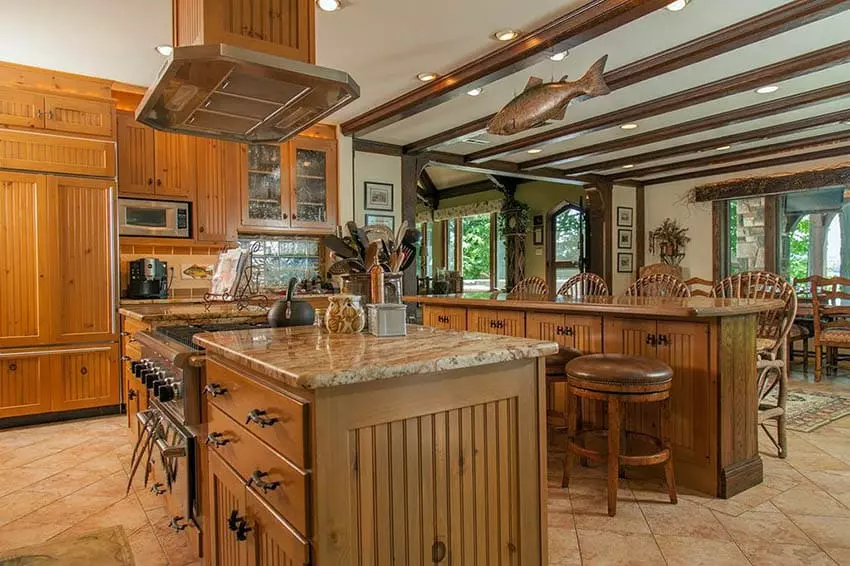 Image source: Sanaulac.vn
Image source: Sanaulac.vn
Characteristics of Rustic Kitchen Cabinets
Rustic kitchen cabinets are known for their distinct features that contribute to their rugged, down-to-earth appeal. Here are some key characteristics of rustic kitchen cabinet design:
-
Rugged Aesthetics: Rustic kitchen cabinets possess a crude, rugged aesthetic that is simultaneously elegant. Unlike modern kitchen cabinets with their sleek, polished appearance, rustic cabinets have an unrefined charm shared with the comfort of country-style kitchens.
-
Natural Appearance and Beauty: Rustic kitchen cabinets showcase a stark, natural appearance and beauty. Inspired by nature, these cabinets often feature natural materials and genuine finishes that enhance their organic appeal.
-
Heartwood and Knotty Woods: Rustic kitchen cabinets prominently feature stunning wooden cabinetry. They make heavy use of solid hardwoods with notable graining patterns, often in clear wood stain finishes. Knotty woods are also a common feature of rustic cabinets, adding an extra layer of character.
-
Faded Paint and Rough Textures: To maintain their rustic appeal, these cabinets often sport weathered stain or faded paint finishes. These finishes enhance the cabinet's rugged aesthetics, complementing the mix of natural textures like stone backsplashes and antique metal hardware.
-
Warm Colors: Rustic kitchen cabinets typically feature warm colors, with rich shades of brown leading the way. Earthy tones like deep reds, greens, and yellows are also used to create a cozy, inviting atmosphere.
-
Raw and Weathered Look: Rustic kitchen cabinets embrace a raw appearance, a timeworn look that exudes character. Imperfections in the wood, such as burls, knots, bird pecks, wormholes, and pits, add to the cabinet's raw and lived-in appeal.
-
Carved Woods: While not heavily ornamented, rustic kitchen cabinets may feature small decorative details carved into the doors. This layering of textures enhances the overall rustic ambiance and adds a unique touch to the cabinets.
-
Robust Cabinetry: Rustic kitchen cabinets are not only visually stunning but built to last a lifetime. These cabinets are traditionally constructed using high-quality materials and construction techniques, ensuring durability and functionality.
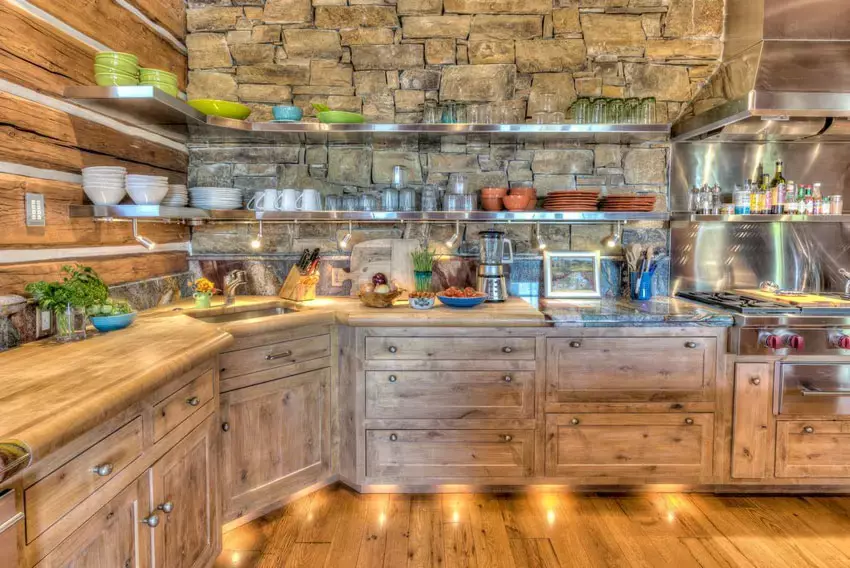 Image source: Sanaulac.vn
Image source: Sanaulac.vn
Finishes for Rustic Kitchen Cabinets
When it comes to finishes, rustic kitchen cabinets should look as though they have been furnished over time. To achieve this timeworn look, rustic cabinets are typically softly distressed or given an artificially weathered surface. Let's explore some commonly used finishing techniques for rustic kitchen cabinets:
Stain Finish
Staining is a popular technique used to enhance the natural features of wooden rustic kitchen cabinets. Wood stains, composed of colorants suspended in alcohol or a finishing agent, highlight the color and graining pattern of real solid wood.
Stains are absorbed by the wood's pores, knots, and grains, resulting in a darker color and more prominent appearance. This finishing technique provides rustic cabinets with a handcrafted look, allowing the natural beauty of the wood to shine. If you want wood to be the centerpiece of your rustic kitchen, opt for a clear stain finish.
Glazing
Glazing, widely used in traditional kitchen settings, adds an antique look and an old-world feel to rustic kitchen cabinetry. Glazes are transparent or semi-transparent liquids applied as top coats to painted or stained cabinets or furniture. The primary purpose of glazing is to add color and provide a glossy shine to wooden kitchen cabinetry.
Glazing is particularly effective when paired with rustic kitchen cabinets featuring details like moldings or carvings. It adds a shadow effect to the carved details and accentuates the corners, edges, and contours of the cabinets.
Glazes come in various colors, such as bronze, mocha, coffee, white, and cream. Two common types of glaze finishes used for rustic kitchen cabinets are dark glaze and white glaze. White glaze pairs well with white rustic kitchen cabinets, while dark glaze provides contrast and highlights the cabinet's features. For a more antique look, combine both glaze colors.
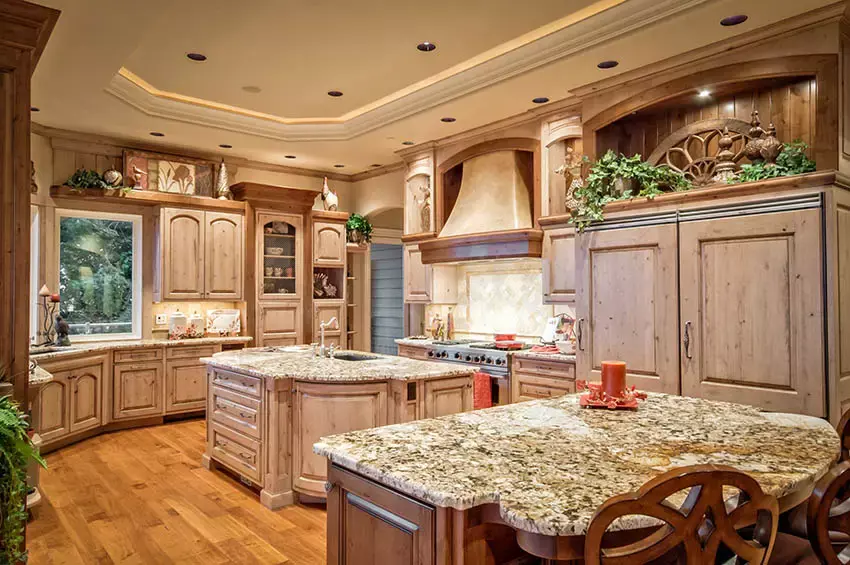 Image source: Sanaulac.vn
Image source: Sanaulac.vn
Weathered Finish
A weathered finish gives rustic kitchen cabinets a worn-out, aged look reminiscent of old fences, seasoned barn planks, or sun-bleached wood. Achieved through a faux finishing technique, weathering simulates the appearance of wood exposed to years of changing outdoor elements like rain, sun, and wind. This process exposes the wood's natural graining pattern, knots, and swirls, resulting in a uniquely textured surface.
Weathered finishes typically involve distressing the wood by hand to create artificial wear and tear. Stains are then applied, followed by a top coat of glaze to highlight the raised grains. After sanding and buffing, the weathered finish reveals an aged appearance with undertones of gray, simulating aged wood.
Distressed Finish
A distressed finish mimics the beauty of true antique furniture and cabinetry. This popular finishing technique gives wood and kitchen cabinetry an antique, time-worn appearance. Distressing, or antiquing, involves creating artificial blemishes on the surface of the cabinets and treating them with an antique glaze.
The distressing process starts with coating the cabinets with primer and sanding to create blemishes. Paint is then applied and repeatedly sanded to add texture. The cabinets are then coated with antiquing glaze, emphasizing the door's details and adding a shadow effect to corners and edges. The distressed finish is perfect for achieving an antique look, particularly on white-colored rustic kitchen cabinets.
Patina and Heirloom Finish
Patina and heirloom finishes give rustic kitchen cabinets an antique look and a timeworn character. These finishes use various techniques, including distressing, sanding, and glazing, to create cabinetry with imperfections and a richly aged appearance.
The heirloom finish involves distressing the wood and applying glaze to accentuate details. By repeating the steps, more imperfections can be added to achieve a rustic and aged appearance. The patina finish, on the other hand, uses additional techniques like dry brushing and a coating of glaze to create an aged appearance with simulated marks and blemishes.
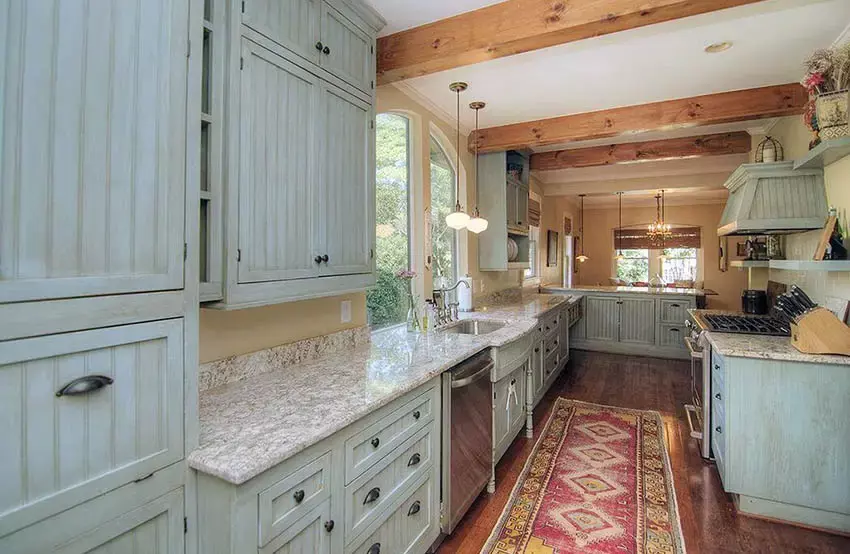 Image source: Sanaulac.vn
Image source: Sanaulac.vn
Rustic Kitchen Cabinet Hardware
Rustic kitchen cabinets feature simple yet defined hardware that complements their unrefined aesthetic. Let's explore the hardware options that best suit the rustic style:
-
Handles and Pulls: Rustic kitchen cabinets often feature rectangular handles and pulls with simple accents like geometric shapes or decorative backplates. Cup bins and pulls, with their semi-circular or half-moon shape, are also popular choices for their vintage look.
-
Knobs: Rustic kitchen cabinets can also incorporate knobs into their design. These knobs are typically round or square with minimal details. Some may feature small contours or borders around the profile for added style.
-
Colors and Finishes: Rustic cabinet hardware stands out and brings contrast to the wooden cabinetry. Popular finishes include black, antique brass, antique iron, and Venetian bronze. These finishes enhance the rustic vibe and add a vintage touch to the cabinets.
 Image source: Sanaulac.vn
Image source: Sanaulac.vn
Rustic White Cabinets
While rustic kitchen cabinets are often associated with warm, natural finishes, another option for achieving a rustic look is with rustic white cabinets. These cabinets feature a distressed or weathered appearance, giving them an unrefined and timeworn look. Instead of a plain white finish, rustic white cabinets are treated with faux finishing techniques to enhance their rustic character.
Rustic white cabinets typically have darker edges or highlighted corners, achieved by applying a glazed coating over stained or painted cabinets. These cabinets are a great alternative for homeowners who find natural wood finishes too heavy on the eyes. Rustic white cabinets work well with various decors and finishes, making them versatile in any kitchen space.
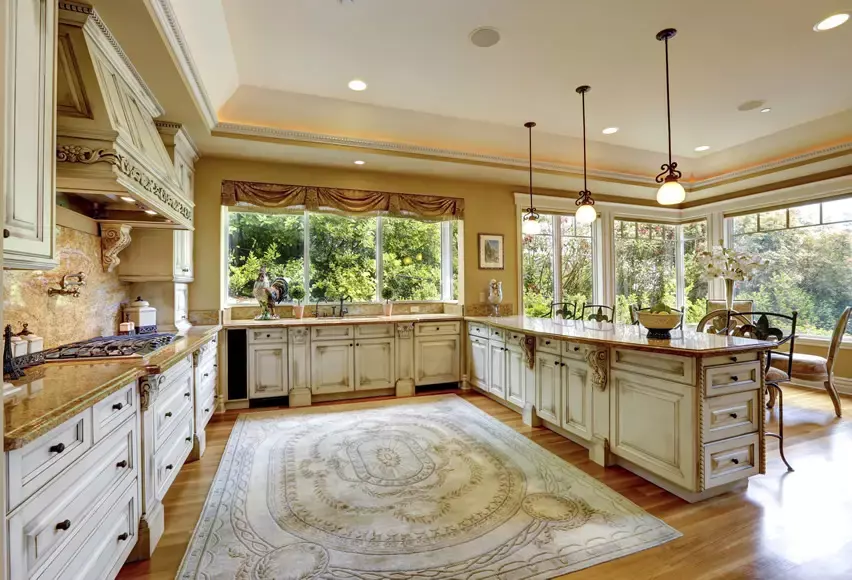 Image source: Sanaulac.vn
Image source: Sanaulac.vn
Rustic Wood Cabinets
Wood is the primary material used for rustic kitchen cabinets, and various wood species offer distinct rustic aesthetics. Let's explore some of the most popular wood species used for rustic cabinetry:
Rustic Hickory Cabinets
Hickory is a North American tree from the walnut family, known for its strength and durability. It features a prominent, close-grained pattern with heavy, flowing grains. Rustic hickory kitchen cabinets boast a dramatic grain variation, making them visually striking. The wood's inherent coarse texture and natural imperfections, such as knots and swirls, add to its rugged appeal.
Hickory kitchen cabinets are not only visually appealing but also extremely durable. Hickory wood is known for its extreme strength, comparable to oak. It withstands the wear and tear of everyday use, ensuring that your rustic cabinets last a lifetime. However, it's important to protect hickory cabinets from moisture, as they tend to discolor when exposed to liquids.
Rustic Alder Cabinets
Alder is a softwood known for its light brown color with reddish undertones. It has a subtle graining pattern and a smooth, uniform appearance, making it an excellent choice for rustic kitchen cabinets. Rustic alder cabinets feature a dramatic grain variation, with fewer knots and defects compared to other woods. This smooth appearance, combined with occasional knotholes, adds character to the cabinets.
Alder is widely used for cabinetry construction due to its strength, reliability, and affordability. It's soft enough to be cut into any shape or form while maintaining its shape without warping. Alder is also commonly used as molding for kitchen cabinetry, thanks to its straight-grained pattern.
Rustic Cedar Cabinets
Cedar is a highly reliable material for interior and exterior applications. It features natural oils that repel insects and decay, making it one of the few wood types that don't require chemical treatment. Rustic cedar cabinets exude a natural elegance with their vibrant colors, rich grain patterns, and uneven weathered look. The wood's natural durability and resistance to humidity and temperature changes make it an excellent choice for kitchen cabinetry.
Western Red Cedar, known for its reddish to pinkish brown color, is a popular choice for rustic cabinets. Its straight grain pattern and medium to coarse texture contribute to its rustic charm. Cedar kitchen cabinets age beautifully, showcasing different tones and turning a grayish color over time.
Rustic Pine Cabinets
Pine is a softwood that is widely available and affordable, making it a popular choice for rustic kitchen cabinets. Knotty pine cabinets are particularly favored for their simple, natural, and raw beauty. This wood species boasts a pale yellow color with occasional brown streaks and a unique knotty appearance that sets it apart from other cabinetry materials.
Pine's natural imperfections, knots, and swirls are embraced in rustic pine cabinets, adding character and texture to the space. These cabinets pair well with warm, earthy tones and can be treated with clear stains to enhance the wood's natural beauty.
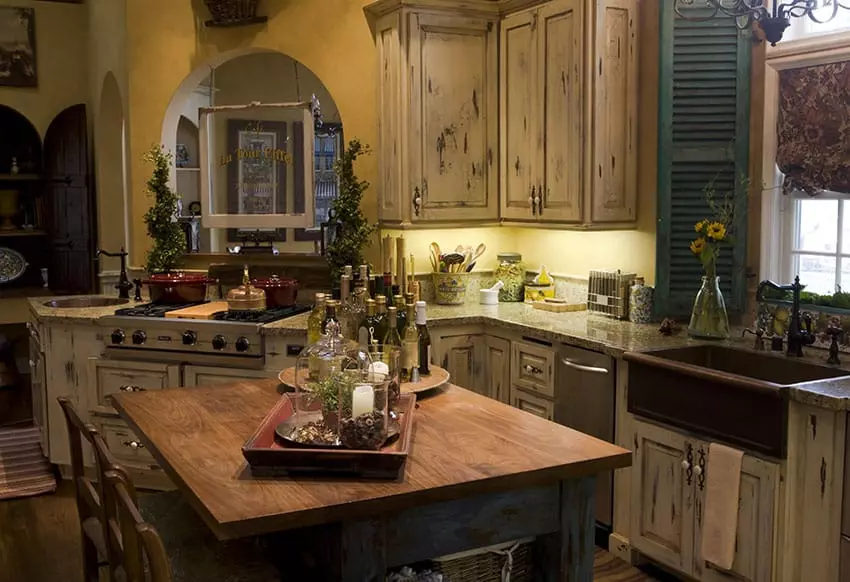 Image source: Sanaulac.vn
Image source: Sanaulac.vn
DIY Rustic Cabinets
If you're feeling adventurous, you can transform your existing cabinets into rustic masterpieces through a do-it-yourself (DIY) approach. Resurfacing your cabinets is a cost-effective way to achieve a rustic look without replacing the entire cabinetry. Here are some DIY solutions to give your cabinets a rustic character:
-
Build Rustic Kitchen Cabinet Doors: By using rough-sawn lumber, you can build your own rustic cabinet doors with a simple flat panel design. Alternatively, you can purchase ready-made stock cabinet doors at local home improvement stores.
-
Resurface Existing Cabinets: Resurfacing your existing cabinets involves changing their appearance through techniques like painting, staining, or distressing. You can also replace the cabinet doors and hardware for a fresh rustic look.
-
Apply Finishing Techniques: To achieve a rustic finish, apply techniques like distressing, weathering, or glazing to your cabinets. These techniques create a timeworn appearance that complements the rustic style.
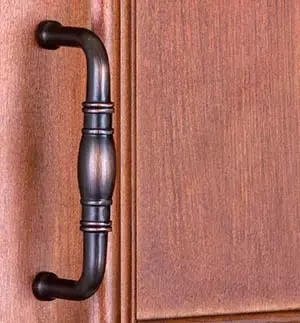 Image source: Sanaulac.vn
Image source: Sanaulac.vn
Rustic Colors for Cabinets
Rustic kitchen cabinets are typically paired with warm colors to enhance their earthy appeal. Rich shades of brown, antique white, cream, beige, and off-white are popular choices for farmhouse-style storage units. These colors create a cozy, inviting atmosphere while reflecting the natural charm of rustic aesthetics.
For a touch of contrast, consider adding earthy accent colors like deep reds, greens, or yellows. However, remember to maintain a neutral color palette inspired by nature to capture the true essence of rustic style.
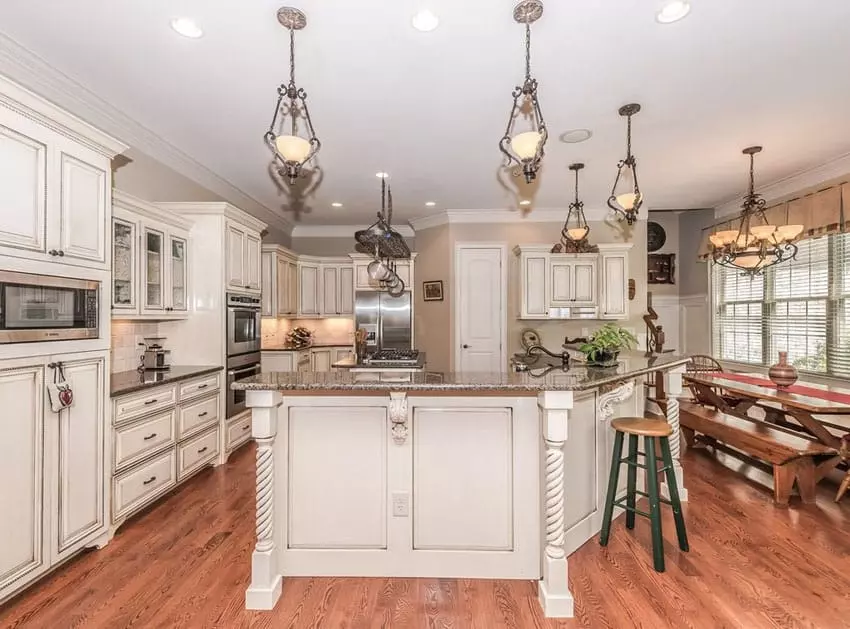 Image source: Sanaulac.vn
Image source: Sanaulac.vn
Farmhouse-Style Storage Unit Ideas
To complete the rustic look of your kitchen, consider incorporating complementary decors and finishes. Here are some ideas for farmhouse-style storage units:
-
Salvaged Wooden Beams: Add a touch of rustic charm by incorporating salvaged wooden beams into your kitchen design. These beams bring authenticity and warmth to the space, creating a genuine rustic atmosphere.
-
Stone Works: Combine rustic kitchen cabinets with natural stone materials, such as stone backsplashes or countertops. These stone accents enhance the overall rustic ambiance and add an organic feel to the space.
-
Wide Floor Planks: Consider installing wide wooden floor planks to complement your rustic cabinetry. These planks provide a warm, inviting base for your kitchen design.
-
Hammered Copper Accents: Incorporate hammered copper accents, like sinks or range hoods, to add a touch of elegance and authenticity to your rustic kitchen.
-
Antique Furniture: If you have the space, consider adding antique furniture pieces, such as an old rustic table and chairs. These statement pieces create a casual dining and entertainment space, perfectly complementing the rustic style.
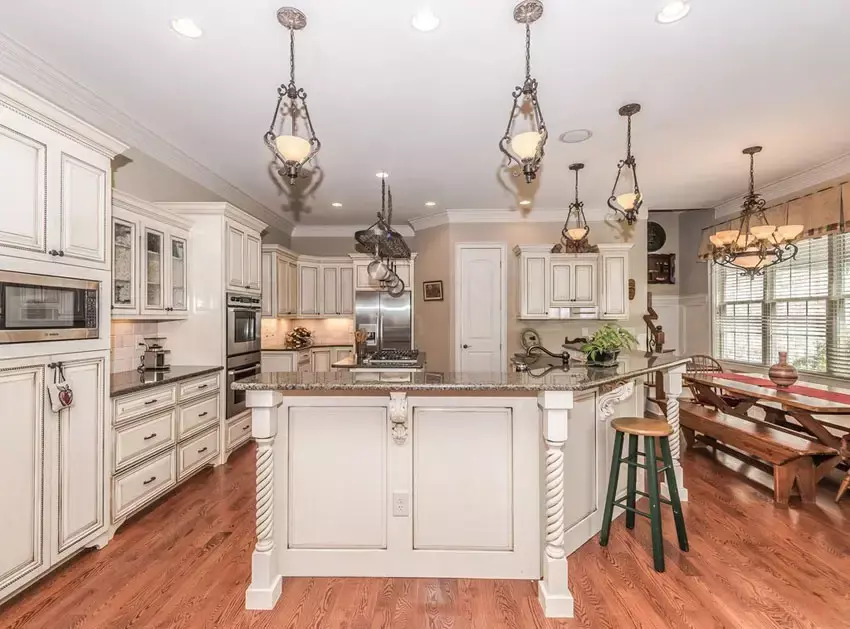 Image source: Sanaulac.vn
Image source: Sanaulac.vn
And there you have it - our ultimate guide to rustic kitchen cabinets! We hope this comprehensive article has provided you with all the information you need to create your dream rustic kitchen. Embrace the warmth, character, and timeless beauty of rustic style, and let your cabinets become the centerpiece of your culinary space. Happy designing!
Note: The images used in this article are for illustrative purposes only and belong to their respective sources.

















